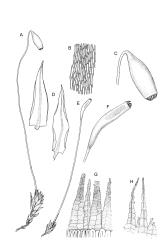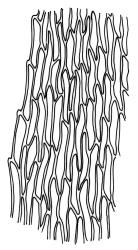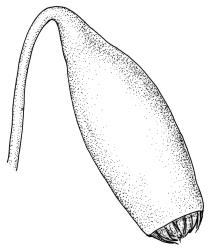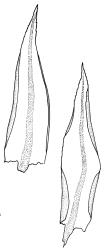- ≡ Webera nutans Hedw., Sp. Musc. Frond. 168 (1801)
- = Bryum longisetum Brid., Bryol. Univ. 1, 636 (1826) nom. illeg.
- ≡ Webera longiseta Brid., Bryol. Univ. 2, 829 (1827)
- ≡ Webera nutans var. longiseta (Brid.) Huebener, Muscol. Germ. 1885 (1885)
- ≡ Pohlia nutans var. longiseta (Brid.) Delogne, Ann. Soc. Belge Microscop. 9: 50 (1885)
- = Bryum bealeyensis R.Br.bis, Trans. & Proc. New Zealand Inst. 31: 457 (1899) – as bealeyense
- = Webera elatior Dixon & Sainsbury in Sainsbury, Trans. & Proc. Roy. Soc. New Zealand 75: 179 (1945)
- ≡ Pohlia elatior (Dixon & Sainsbury) Sainsbury, Rev. Bryol. Lichénol., n.s. 21: 219 (1952)
Plants gold-green or pale green, not glaucous when fresh, not lustrous, forming turves. Stems variable in length, to at least 20 mm, unbranched, red-brown, in cross-section angular, with incrassate cortical cells and a conspicuous central strand, beset (often sparsely) with red-brown, papillose rhizoids. Leaves closely spaced, more crowded and larger towards shoot tip (lacking a clear distinction between vegetative and perichaetial leaves), erect, little altered when dry, ovate- or ovate-lanceolate, acute or acuminate, weakly toothed above, entire and narrowly or strongly recurved at margins below, not decurrent, mostly 2.2–3.0 long × 0.5–0.7 mm (but smaller below); upper laminal cells linear, mostly 60–75 × c. 10 µm, thick-walled, not altered at apex, becoming ± shorter and wider towards insertion. Costa stout, mostly percurrent to short-excurrent, in cross-section (at mid leaf) semi-circular on abaxial surface, with 3–4 median guide cells, a large abaxial and a smaller adaxial stereid band. Axillary gemmae nil.
Paroicous or synoicous. Perichaetia terminal, the ♀ leaves grading into the vegetative leaves, lacking paraphyses, with antheridia present in axil of outer ♀ leaves or occasionally intermixed with perichaetia. Perigonia nil; antheridia numerous and mostly easily observed among the outer perichaetial leaves. Setae single, yellow- or red-brown, flexuose, variable in length but mostly c.18–35(–70) mm; capsules horizontal to pendent, narrowly pyriform, with a neck c. ½ the length of the urn, orange-brown, mostly 2.5–4.0 mm; annulus strongly differentiated, revoluble; stomata superficial; operculum conic. Exostome teeth pale, lanceolate, narrowly bordered, very finely papillose on outer surface, strongly trabeculate on inner surface; endostome with a high basal membrane, with widely perforate segments that are nearly the height of the teeth and nodose to appendiculate cilia in pairs or 3s. Spores small, 12–18 µm, pale brown, appearing smooth.
Crum & Anderson 1981, fig. 244 a–g; Beever et al. 1992, fig. 39; Malcolm & Malcolm 2003, p. 52; Shaw & Ramsay 2013, unnumbered fig.
Smith’s (2004, p. 600) statement that despite its variability P. nutans is usually an easily recognised plant is correct. In occasional specimens the paroicous nature of the inflorescence cannot be demonstrated, but in such cases the thick-walled and elongate nature of the laminal cells point to this species. The dry, appressed leaves, pigmented and protruding costae, and recurved margins sometimes give the gametophytes of this plant a vague resemblance to Ceratodon purpureus.
Pohlia nutans is sometimes confused with P. cruda, but differs from it by its lack of sheen and its thicker-walled upper laminal cells. Pohlia nutans is invariably paroicous or synoicous (in N.Z.), whereas P. cruda is mostly dioicous and bears conspicuous terminal perigonia in some plants.
Confusion sometimes occurs with Mielichhoferia bryoides, particularly when sterile. The presence of secondary red pigments in the stem and costae, the thicker-walled upper laminal cells, and the terminal perichaetia in the present species should prevent confusion. The upper marginal teeth in the present species are less pronounced and do not project from the margin as widely as do those in M. bryoides, which project from the margin in a highly characteristic manner. The two species could not be confused when fruiting, given the marked differences in capsule stance and the nature of their peristomes.
NI: N Auckland (Ahipara, Waipoua) including offshore islands (TK), S Auckland, Taranaki (Fantham’s Peak), Wellington; SI: Nelson, Canterbury, Westland (Jacksons Bay), Otago, Southland (Invercargill, Awarua Bog); Ch; A; C. No convincing material has been seen from Gisborne, Hawke’s Bay, or Marlborough L.D. (despite Sainsbury’s 1955 report from the last), or from St. Only one collection has been confirmed from Westland L.D.
Cosmopolitan. Tasmania*, mainland Australia*, Patagonia*. Crum & Anderson (1981) considered it to be widespread in both the northern and southern hemispheres.
Pohlia nutans occurs in a wide range of terrestrial habitats but is best developed when growing in Sphagnum bogs, at tarn margins, or in wet tussock grasslands. Its many other habitats include roadside banks, glacial rubble, crevices in rock outcrops, dune slacks, rotten wood, and Leptospermum/Kunzea scrub. Material has been seen from peat that had been burnt 39 months prior (P.N Johnson 52, CHR 242737, from Awarua Bog). Smith (2004) considers it to be “especially characteristic of acidic peaty or sandy soil” in Britain. Material collected from bogs and similar damp, acidic, and highly insolated sites is often much larger in stature than material from other habitat types. A single collection (M.F. Sinclair s.n., CHR 491858, named by K.W. Allison) has been collected growing as a “weed in [a] water-logged pot” in a glasshouse in Christchurch; the material seems correctly named. On the North I. documented from 350 m (Waiotapu, S Auckland L.D.) to at least 1190 m (Tararua Range, Wellington L.D.), with one record from c. 2440 m (Mt Girdlestone, Wellington L.D.). On the South I. ranging from near sea level (Waitātī, Otago L.D. and Invercargill) to at least 1900 m (above the Caroline Glacier in Mt Cook National Park, Canterbury L.D.). Associated species are accordingly diverse and frequently include members of the genera Bartramia, Chrysoblastella, Conostomum, Ditrichum, Philonotis, Polytrichum, and Sphagnum.
Pohlia nutans is a highly variable species, but a suite of features facilitate its recognition, particularly the elongate to linear and thick-walled upper laminal cells, the stout costa, the weakly toothed upper margins, which are recurved towards the insertion, as well as the paroicous (sometimes synoicous) inflorescence, paired (–3) and strongly nodose endostomal cilia, and inclined, relatively short-necked capsules, which all aid the recognition of this widespread species. Very often specimens that lack sporophytes have sex organs, and the usually paroicous distribution of the antheridia greatly aids recognition. The occurrence of up to four endostomal cilia, as noted by Sainsbury (1955, p. 261), has not been confirmed.
As in the northern hemisphere material (Crum & Anderson 1981; Smith 2004), P. nutans from N.Z. often has exceedingly long and delicate setae. Plants with setae greater than c. 35 mm usually occur in bogs or other wet and insolated habitats. Both Crum & Anderson (1981) and Smith (2004) noted that P. nutans is variable in chromosome number.
A collection of P. nutans from Maungatua (Otago L.D.) by J. Child 6088 [CHR 429247] was (in 1995?) tentatively considered by J. Shaw to represent a species of Pohlia unknown for New Zealand, which he (in herb.) termed “Pohlia species Y”. Shaw’s tentative opinion is not accepted here.
Pohlia elatior is retained in synonymy here (rather than in Bryum pseudotriquetrum, as stated in Fife 1995) partly on the strength of a 1995 annotation of the holotype by J. Shaw. In an earlier annotation he considered it a “lush form of Pohlia nutans”. It is highly aberrant material, with very elongate (to 35 mm) stems, and appears (despite Dixon’s comments that it is male material of a dioicous species, quoted by Sainsbury 1955, p. 359) to lack any sex organs. The costae are variable in length from subpercurrent to excurrent, the upper laminal cells are elongate and firm- to thick-walled, and the margins are as per P. nutans. The extremely aberrant morphology of the type collection is likely to be due to the great altitude of the collection site (c. 8000 feet, or 2440 m). It could be argued that Dixon and Sainsbury were unwise to describe a new species from sterile and apparently non-representative material. There seems to be no useful purpose served by questioning Shaw’s 1995 determination; it seems desirable that the poorly founded name Pohlia elatior fade from usage.
The name P. nutans var. longiseta Huebener was applied by Dixon (1926) to material collected near Bealey (Canterbury L.D.) by R. Brown. The material in question (CHR 491857) is unexceptional in the context of P. nutans in N.Z. and the name seems to have little or no currency in modern European or British floras. The name was not applied by Sainsbury (1955, p. 261) and is not considered further here.








